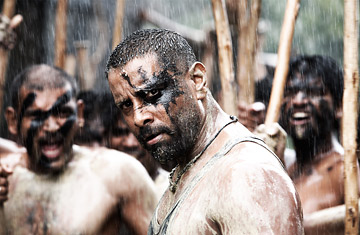
A scene from Raavan
(2 of 2)
While Raavan may not be not up there with Nayakan, Roja, Bombay and Dil Se, it's very recognizably a Mani Ratnam film. His work often touches on controversial real-life figures (Mafia bosses, revolutionaries) and incendiary political issues (terrorist kidnappings, the Bombay riots of 1992-93, the Sri Lankan war), and Raavan is no exception. Ahbishek's Beera, while clearly a version of The Ramayana's Ravana character, is also reputed to be partially based on Kobad Ghandy, a Maoist leader of the ongoing Naxalite insurgency in northern India.
One big difference: Ghandy is a well-educated, world-traveled theoretician; Beera is a primitive warrior. Bachchan plays him as a creature of wild gestures and grimaces, ever slapping his cranium and making chaka-chaka-chaka grunts, with a flashing of clenched teeth not seen since Kirk Douglas and Burt Lancaster had their showdown at the O.K. Corral. It's a performance both feral and mopey, as if Sly Stallone had taken a crash course in the Stanislavski method before going into the jungle to play Rambo. And when Beera holds Ragini captive, the unmistakable point of reference is the fable of Beauty and the Beast. To put it in movie-monster terms, she is Faye Wray and he the Ramayana King Kong.
What's odd is the lack of chemistry between kidnapper and victim, considering that the actors who play them are husband and wife. The love story the audience expects to develop has no hint of physical or even emotional intimacy. That's partly because the clash of acting styles is as large as the chasm separating Ragini and Beera and partly because Rai, while easy to look at, lacks the spark of a natural performer. In Guru, Abhishek had said moonily to Aishwarya, "You shine as beautifully as polyester," and Rai is always a fairly synthetic actress. The genuine screen charisma here is provided by the Tamil ingénue Priyamani, who invests the supporting role of Beera's stepsister with a flirtatious charm during her bridal scene, then aching despair when the police violate her on her wedding night. And for the film's core emotional connection, you must look to the relationship of the stalwart policeman Dev and his loving wife Ragini.
Spoiler alert: The Dev-Ragini conflict really kicks in at the end of the film, when they are reunited after his footbridge fight with Beera. Suddenly flashing signs of jealousy, the inspector impugns his wife's loyalty to him, and she returns to Raavan. Turns out Dev does believe Ragini; driving her away was his scheme to follow her trail back to Raavan, surround the outlaw with a police posse and kill him. So this is the story of a cop who loves and trusts his wife, yet puts her life in jeopardy by using her as a pawn to get his man. It's another instance of Ratnam saving his coolest surprises for the very end of a film — as in the 1998 Dil Se, where journalist Shahrukh Khan falls for separatist-terrorist babe Manisha Koirala and, as she is about to detonate a suicide bomb that will kill a local politician, embraces her in a final act of love and patriotism. End alert.
The movie looks terrific. This bucolic melodrama is set in some of India's most spectacular natural settings, including Kerala's Athirappilly Falls (which Ratnam also used in Iruvar and Guru), the lush hills of Malshej Ghat near Mumbai and the forests of Karnataka. Cinematographer Santosh Sivan contrasts the lushness of nature with Beera's monochromatic mud war paint and the chalk-smeared faces of his followers, similar to the camouflage daubs worn by Martin Sheen and the Vietnamese natives in Apocalypse Now. In familiar Ratnam fashion, the camera often does 360-degree wind sprints around the actors. When the director creates a compelling fictional universe in other films, his camerabatics express the turbulence of characters in extremis. Here, the whirling technique is a case of going nowhere fast.
As a showcase for some of Indian cinema's most renowned talents, Raavan has to be considered a disappointment. But as a big summer epic about a forest bandit, hey — it's better than the Russell Crowe Robin Hood. And, thanks to A.R. Rahman's infectious songs, this one you can dance to.
